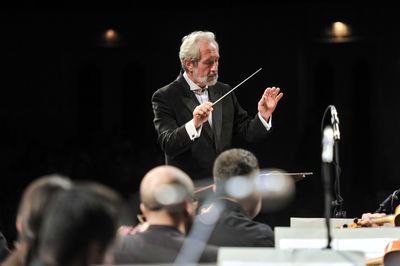
In a rare spring appearance, the National Orchestra of Iran, led by Homayoun Rahimian and featuring renowned vocalist Abdolhossein Mokhtabad, took the stage at Vahdat Hall on June 8 and 9, 2024, delivering a concert marked by nostalgic melodies, strong vocal performances, and noticeable rhythmic challenges that underscored the ensemble’s ongoing need for tighter coordination.
The National Orchestra of Iran, conducted by Homayoun Rahimian and featuring Abdolhossein Mokhtabad, performed a concert titled “Dar Rahgozarat” (In Your Passage) on June 8 and 9, 2024 at Vahdat Hall.
This concert marked the first performance of the National Orchestra of Iran in the current year. That is, while we are already in the final days of spring and the first quarter of 1403 [2025], the orchestra only now took the stage for its debut performance of the year. If this trend continues, it appears the National Orchestra may plan to perform only once each season!
The program featured several vocal pieces sung by Mokhtabad, including Faryad-e Bi-Qarari, Shabangahan, Bahār-e Eshgh, Naqsh-e Khiyāl, Shokuh-e Shabhāye Royāyi, Tamannā-ye Vesāl, and Khushe Chin. Two instrumental works were also performed: Rangārang by Rouhollah Khāleghi and Naghamé-ī dar Shur composed and arranged by Amirhossein Tāee.
In terms of performance quality, one thing stood out clearly: rhythmic issues were the Achilles’ heel of the orchestra in this concert. There were noticeable coordination problems between sections, mistimed entrances of some instruments, and irregularities that any moderately attentive listener could catch.
Among the most glaring issues was the lack of synchronization between Iranian percussion instruments (daf and tonbak) and the rest of the orchestra. In many pieces, the tonbak was notably ahead of the beat — a problem that could even make things more challenging for the vocalist. Ritardandos at the end of pieces were also loosely executed, and the strong, cohesive final cadences that audiences expect were often lacking.
As for pitch and note accuracy, there were few significant errors — likely because the pieces in this program didn’t pose much technical challenge for the orchestra’s musicians. As mentioned, the main issue lay in rhythmic coordination, which may partially stem from the conductor’s approach. Perhaps rehearsals should have placed more emphasis on rhythmic alignment, and during the concert itself, the conductor’s gestures could have offered more precise and emphatic cues for entries.
That said, the orchestra delivered a respectable performance in the two instrumental pieces. The rhythmic problems in these works were also less noticeable. The instrumental piece Naghamé-ī dar Shur — scored for string orchestra, with a slow tempo and sustained notes — aimed to evoke emotion through dynamic nuances and was executed quite beautifully.
In the vocal section, we witnessed a warm and heartfelt performance by Master Mokhtabad. Since he himself had composed most of the pieces, a smooth and confident delivery was expected — and that’s exactly what was delivered.
Overall, it was an enjoyable evening, especially for a generation that holds deep memories tied to the voice of Abdolhossein Mokhtabad. The enthusiastic presence of his fans in Vahdat Hall underscored this sentiment.
Written By Farid Parish
